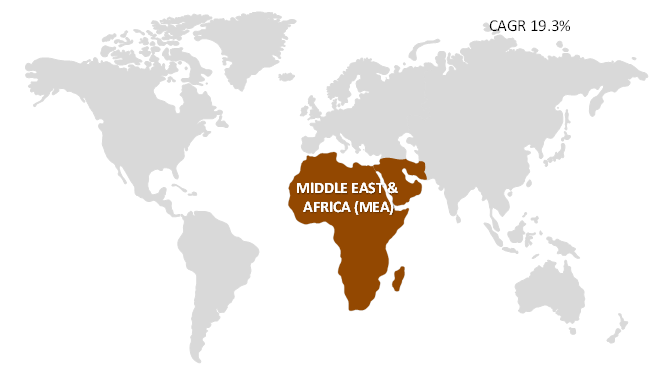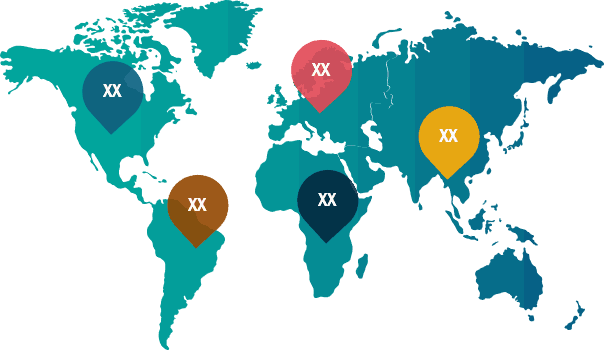The Middle East & Africa pressure vessel composites material market accounted to US$ 65.98 million in 2019 and is projected to account US$ 269.04 million by 2027; it is expected to grow at a CAGR of 19.3% during 2020–2027.
Pressure vessel composite materials are used in pressure vessels used to store gases and liquids under high pressure. The strength of the vessel is the crucial parameter used to avoid explosions as a result of the rupture. A composite material is a combination of materials which vary in composition or shape on a macro scale. These materials do not dissolve or otherwise blend entirely into each other. The composite overwrapped pressure vessel (COPV) is pressure-containing, that is used in spaceflight owing to its low weight and high strength. Infinite composites technologies said substituting heavy metallic structures with composites would allow space exploration to develop by creating reusable rockets, increasing fuel requirements, and lowering the cost of sending goods into orbit. The company has colluded with NASA and Yeti Space and is now currently designing and researching propellant tanks using the iCPV technology for the classified space business. Moreover, according to the Office of Health and Mission Assurance, NASA uses a wide variety of PVS in-flight applications, including both composite overwrapped pressure vessels (COPVs) and metallic, piping, and valves typically to store liquids and gases that are necessary for either the launch phase or operations on orbit. Their reliability is essential as once such vessels leaves the pad, they regularly cannot be serviced or checked unless and until they return to earth. Typically, they follow a stringent certification and acceptance testing plan to ensure the project requirements are met. Hence, the increasing use of pressure vessel composite materials for space technology drives the market growth in the forecast period.
The COVID-19 pandemic first began in Wuhan (China) in December 2019, and since then, it has spread at a fast pace across the globe. As of February 2021, South Africa, Saudi Arabia and UAE are among the worst-affected countries in terms confirmed cases and reported deaths. The pandemic has been affecting economies and industries in various countries due to lockdowns, travel bans, and business shutdowns. Shutdowns of chemicals and materials industry and disruptions in supply chains due to lockdown of countries has created a strain on the supplies of the various products offered by this industry. The South Africa has the highest number of confirmed cases of COVID-19 infection among all Middle East & African countries. This is impacting the chemicals and materials industry as the shutdowns in the country are affecting the Middle East & African supply and distribution chains. In addition, the pandemic would also affect overall manufacturing processes, research, and development activities.
Middle East & Africa Pressure Vessel Composites Material Market

- This FREE sample will include data analysis, ranging from market trends to estimates and forecasts.
- This FREE sample will include data analysis, ranging from market trends to estimates and forecasts.
Market Insights
Increasing Demand for Pressure Vessels from Various End-User Industries
The chemicals industry is growing in Middle East & Africa due to the increasing consumption of goods such as fertilizers and other agrochemical products, coatings & adsorbents, LED lightings, plastics, and human-made fibers, and research laboratory chemicals. Also, according to the International Council of Chemical Associations (ICCA), the chemical industry was valued at USD 5.7 trillion in 2019, which was equivalent to a 7% share in the global GDP. Also, the petrochemical industry is encountering heightened demand from various construction projects around the world. Pressure vessels are designed to work by entering the pressure required to make an application function, like holding air in a scuba tank. It can deliver pressure either directly by valves and release gauges or indirectly via heat transfer. Potential pressure levels ranges from 15 psi to 150,000 psi, whereas temperatures are usually above 400°C (750°F). A pressure tank can hold anywhere from 75 liters (20 gallons) to many thousand liters. Pressure vessels are used in different industries, but three industries cover most of the market. These industries are the chemical industry, oil and gas industry, and the energy industry. Steel alloys includes chromium-molybdenum alloys, carbon steel, and stainless steel. Carbon steel is a compound of iron and steel; however, stainless steel is an iron alloy with a minimum of 10.5% chromium. Other elements are added to the stainless steel to enhance its properties and structure, such as strength and formability. Also, high corrosion resistance is the main characteristic of good grade stainless steel. The growth in the number of industrial power projects and the replacement of existing pressure vessels are the significant factors propelling market growth. The factors boosting the market include increasing upstream & downstream activities in the oil & gas industry, expanding power generation capacities, increasing chemical projects, and surging demand for electricity.
Material Based Insights
The pressure vessel composites material market based on material has been segmented into resin, fiber and others. In 2019, the resin segment accounted for a larger share of the Middle East & Africa pressure vessel composites material market, and is also expected to grow at a higher CAGR during the forecast period. Resin or epoxy resin is widely used in the pressure vessel composite materials market to produce pressure vessels. As for the class of vessels, plastic-lined composite tanks are anticipated to see the most accelerated growth across the next five years and so is the market for epoxy resins in this category of a vessel as plastic-lined composite tanks uses more numerous carbon epoxy composites and also provides maximum weight savings compared to other types of pressure vessels. Plastic-lined composite tank form is frequently penetrating, especially in mass transit buses and medium and heavy commercial vehicles. Lower fuel density and lower mass of these vessels allow for more excellent range and fuel efficiency for medium and heavy-duty commercial vehicles, and also longer operating times between refuelling stops and reduced maintenance costs. The epoxy resins segment had a significant market share, and this trend is expected to continue over the forecast period. Factors such as its high weather-resistant properties, mechanical and adhesive properties play a substantial role in the epoxy resins segment to maintain its market position.
Middle East & Africa Pressure Vessel Composites Material Market, by Material – 2020 and 2027
End User Based Market Insights
Based on end user, the pressure vessel composites material market is segmented into CNG vehicles, hydrogen vehicles, gas transport and others. In 2019, the CNG vehicles segment dominated the Middle East & Africa pressure vessel composites material market; whereas, the hydrogen vehicles segment is expected to grow at the fastest rate during 2020–2027. CNG vehicles held a significant share in the Middle East & Africa pressure Vessel Composite Materials Market due to the lower cost as compared to the other vehicles. The pressure vessel's outer shells are made up of a conventional metal alloy, which is used to store fuel in a truck, car, or bus equivalent to a gas tank for a combustion engine or applications for bulk storage. Composite CNG pressure vessel has more safer burst behaviour for passenger vehicles as opposed to metallic CNG. Also, the lining used for CNG pressure vessels are made from HDPE, and carbon fibers are used to wind the vessel filament and be used in diesel fuel, gasoline, and liquefied petroleum gas (LPG). CNG combustion also produces fewer undesirable gases than diesel fuel, gasoline, and liquefied petroleum gas mentioned fuels. Natural gas poses more limited of a threat in the event of a spill than other liquids, as it is lighter as compared to air and disperses quickly when released. The metallurgical skills and equipment needed to produce them are broadly available across Middle East & Africa. Also, CNG counterparts reduce the weight of the storage container by 30-40%. CNG vehicles have a very high-octane rating that enables them to run smoother. Thus, CNG vehicles drive the pressure Vessel Composite Materials market growth in the forecast period.
Customize This Report To Suit Your Requirement
You will get customization on any report - free of charge - including parts of this report, or country-level analysis, Excel Data pack, as well as avail great offers and discounts for start-ups & universities
Middle East & Africa Pressure Vessel Composites Material Market: Strategic Insights
Middle East & Africa Pressure Vessel Composites Material Market
-
Market Size 2019
US$ 65.98 Million
-
Market Size 2027
US$ 269.04 Million

Market Dynamics
GROWTH DRIVERS
- XXXXXXX
- XXXXXXX
- XXXXXXX
FUTURE TRENDS
- XXXXXXX
- XXXXXXX
- XXXXXXX
OPPORTUNITIES
- XXXXXXX
- XXXXXXX
- XXXXXXX
Regional Overview

- Middle East and Africa
Market Segmentation
 Material
Material
- Resin
- Fiber
 End User
End User
- CNG Vehicles
- Hydrogen Vehicles
- Gas Transport
- Get Top Key Market Trends of this report.This FREE sample will include data analysis, ranging from market trends to estimates and forecasts.
Middle East & Africa Pressure Vessel Composites Material MarketReport ScopeMiddle East & Africa Pressure Vessel Composites Material Market Report Scope
Report Attribute
Details
Market size in 2019
US$ 65.98 Million
Market Size by 2027
US$ 269.04 Million
Global CAGR (2020 - 2027)
19.3%
Historical Data
2017-2018
Forecast period
2020-2027
Segments Covered
By Material - Resin
- Fiber
By End User - CNG Vehicles
- Hydrogen Vehicles
- Gas Transport
Regions and Countries Covered
Middle East and Africa - South Africa
- Saudi Arabia
- UAE
- Rest of Middle East and Africa
Market leaders and key company profiles
3M Company
BASF SE
Hexion Inc.
Huntsman International LLC.
Olin Corporation
Solvay S.A.,
ZOLTEK Corporation (Toray Group)
Customize This Report To Suit Your Requirement
You will get customization on any report - free of charge - including parts of this report, or country-level analysis, Excel Data pack, as well as avail great offers and discounts for start-ups & universities
Middle East & Africa Pressure Vessel Composites Material Market: Strategic Insights
-
Market Size 2019
US$ 65.98 Million -
Market Size 2027
US$ 269.04 Million

Market Dynamics
- XXXXXXX
- XXXXXXX
- XXXXXXX
- XXXXXXX
- XXXXXXX
- XXXXXXX
- XXXXXXX
- XXXXXXX
- XXXXXXX
Regional Overview

- Middle East and Africa
Market Segmentation
 Material
Material - Resin
- Fiber
 End User
End User - CNG Vehicles
- Hydrogen Vehicles
- Gas Transport
- Get Top Key Market Trends of this report.This FREE sample will include data analysis, ranging from market trends to estimates and forecasts.
| Report Attribute | Details |
|---|---|
| Market size in 2019 | US$ 65.98 Million |
| Market Size by 2027 | US$ 269.04 Million |
| Global CAGR (2020 - 2027) | 19.3% |
| Historical Data | 2017-2018 |
| Forecast period | 2020-2027 |
| Segments Covered |
By Material
|
| Regions and Countries Covered | Middle East and Africa
|
| Market leaders and key company profiles |
- Historical Analysis (2 Years), Base Year, Forecast (7 Years) with CAGR
- PEST and SWOT Analysis
- Market Size Value / Volume - Global, Regional, Country
- Industry and Competitive Landscape
- Excel Dataset



Report Coverage
Revenue forecast, Company Analysis, Industry landscape, Growth factors, and Trends

Segment Covered
Material, End User, and Country

Regional Scope
North America, Europe, Asia Pacific, Middle East & Africa, South & Central America

Country Scope
Saudi Arabia
Trends and growth analysis reports related to Chemicals and Materials : READ MORE..
- 3M Company
- BASF SE
- Hexion Inc.
- Huntsman International LLC.
- Olin Corporation
- Solvay S.A.,
- ZOLTEK Corporation (Toray Group)
 Get Free Sample For
Get Free Sample For